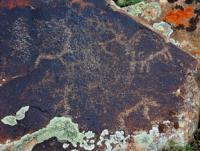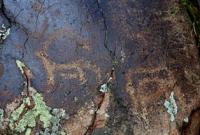Вы здесь
Petroglyphs of Kalmakemel.



Favourite stays in Kazakhstan.
«Memory is the treasure house of the mind wherein the monuments thereof are kept and preserved»
Thomas Fuller.
Beach holiday on Caspian Sea Aktau.
The Kalmakemel Mountains are in the Karaganda Region, 70km north-west of Sayak City. In 2007, the Kalmakemel petroglyphs were researched and documented by Rogozhinskiy A.E. who drew up an archeological map and photographed the petroglyphs.
Abroad valley, with habitation sites dated to the Neolithic, the Middle Ages, and the XIXth - XXth centuries, and Early Iron Age kurgan burial sites, intersects with a low mountain massif from east to west. The most ancient sites include two identified dwellingsites/workshops from the Upper Paleolithic.
On the left slope of the gorge, petroglyphs are found in especially large quantities in the middle part of the valley, with a total of about 2,000 images, which makes it the most important Northern Near Balkhash Area site.
Мost engravings date to the Bronze Age, with numerous horses, hunting scenes, solar signs and others. Other periods are represented to a lesser degree, but also with expressive images, such as deer in Early Saki style, a medieval image of a dog in a heraldic pose, and others.
The most ancient Kalmakemel petroglyphs are superficially pecked, apparently with a stone tool. Hundreds of images are of horses; other animals were rarely depicted – ox, deer, dogs; images of humans are sporadic.
The horses, similar and realistic, are short-legged with a drooping abdomen and a massive head with a small mane. They are followed by mares with foals. Their legs are connected to one line below. Humans are shown controlling the animals by flinging a rope on their necks or hunting and striking them with an arrow.
The opposition between humans as masters and animals is emphasized by specific drawing techniques or the skillful use of nuances on the surface. A couple of harnessed horses proves that ancient Kalmakemel petroglyphs depicted a community of early cattle-breeders, where animal hunting and taming went along with the use of domesticated animals.
Iconographic and stylistic parallels with artistic bronze objects of the Seymin-Turbin type date the petroglyphs to the first half of the 2nd century BC. Among Kazakhstan rock art sites, the Akbidayik engravings of northeastern Saryarka are closest in content to the Kalmakemel petroglyphs. In the south-east of the region, analogies include engravings at Terekty Aulie and Baykonur River Valley, distinguished by the presence of Bactrian camel images.
Late Bronze Age engravings are prominent, even if not very numerous, at Kalmakemel with horse drawn chariots, battle scenes and solar scenes – i.e. the whole range of Kazakhstan themes for that period. The repertoire of petroglyphs from early and medieval nomads is much richer than at Besoba, but their quantity is still small, with isolated silhouettes of a deer, horse hooves and other animals in the style of Western Mongolia and Altai “deer” rocks.
A composition with human figures vividly resembles original drawings of the Tagarian culture in the Minusinsk Basin. Medieval petroglyphs are inexpressive, but they include tamgas, also found on other sites from the Altai to Tarbagay to the Chu Valley.
Later petroglyphs are concentrated near wintering grounds dating to the late XIXh - early XXth centuries, represented with quite realistic engravings; Kazakh tamgas are frequent.
Authority:
“Rock Art Sites in Kazakhstan”. Alexey E. Rogozhinskiy.
Photo by
Alexander Petrov.






